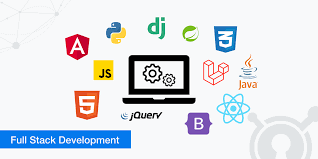Becoming a Full-Stack Developer in 2024
Published on 12/23/2024

Introduction
In 2024, the demand for full-stack developers continues to rise, making it one of the most sought-after roles in the tech industry. A full-stack developer is a jack-of-all-trades, skilled in both front-end and back-end development. This versatility allows them to build complete web applications and work seamlessly across the technology stack.
If you’re looking to start or advance your journey as a full-stack developer, this guide will help you navigate the skills, tools, and strategies needed to thrive in 2024.
What is a Full-Stack Developer?
A full-stack developer is someone proficient in both:
- Front-End Development: Focused on the user interface (UI) and experience (UX). This involves working with HTML, CSS, JavaScript, and frameworks like React or Vue.js.
- Back-End Development: Focused on server-side logic, databases, and APIs. This involves working with languages like Node.js, Python, or Java, and database systems like MongoDB or PostgreSQL.
In short, a full-stack developer can build an entire application from scratch.
Why Choose a Career as a Full-Stack Developer?
- High Demand:
Companies are always on the lookout for developers who can handle both front-end and back-end tasks. - Versatility:
Full-stack developers have a broader skill set, making them valuable across various projects and industries. - Lucrative Salaries:
Full-stack developers often earn higher salaries due to their diverse expertise. - End-to-End Ownership:
You get the satisfaction of seeing a project through from concept to completion.
Skills Required to Become a Full-Stack Developer in 2024
1. Front-End Skills
- HTML & CSS: The foundation of web development. Learn semantic HTML and modern CSS techniques (e.g., Grid, Flexbox).
- JavaScript: Master JavaScript to create dynamic, interactive UIs.
- Front-End Frameworks:
- React.js: The most popular front-end library in 2024.
- Vue.js: A lightweight alternative for building user interfaces.
- Next.js: The go-to framework for building React-based web applications.
2. Back-End Skills
- Programming Languages:
- Learn a versatile language like JavaScript (Node.js), Python, or Java.
- Frameworks and Libraries:
- Node.js + Express: The most widely used stack for JavaScript-based back-end development.
- Django/Flask: Python-based frameworks for rapid development.
- APIs: Learn how to build and consume RESTful and GraphQL APIs.
3. Databases and Storage
- Relational Databases: Learn SQL and work with systems like PostgreSQL or MySQL.
- NoSQL Databases: Understand NoSQL solutions like MongoDB for scalable applications.
- Version Control: Master Git for tracking changes in your codebase.
4. Deployment and DevOps
- Cloud Platforms: Gain hands-on experience with platforms like AWS, Google Cloud, or Azure.
- CI/CD Pipelines: Automate testing and deployment using tools like GitHub Actions or Jenkins.
- Containerization: Learn Docker for creating portable applications.
Tools and Frameworks to Learn in 2024
1. Front-End Tools
- React.js: Still the leader in 2024.
- Tailwind CSS: The most popular utility-first CSS framework.
- TypeScript: A strongly typed superset of JavaScript for safer code.
2. Back-End Tools
- Node.js: Preferred for building scalable server-side applications.
- Express.js: A minimal and flexible Node.js web application framework.
- NestJS: A framework for building efficient, reliable, and scalable server-side applications.
Step-by-Step Guide to Becoming a Full-Stack Developer
Step 1: Master the Fundamentals
- Learn the basics of HTML, CSS, and JavaScript.
- Build static websites to solidify your understanding.
Step 2: Learn a Front-End Framework
- Start with React.js or Vue.js for creating dynamic, interactive UIs.
- Build small projects like a to-do app or a portfolio website.
Step 3: Dive into Back-End Development
- Learn Node.js with Express.js for building APIs and handling server-side logic.
- Create a CRUD (Create, Read, Update, Delete) application connected to a database.
Step 4: Learn Databases
- Work with MongoDB for NoSQL or PostgreSQL for SQL-based databases.
- Understand how to structure and query data effectively.
Step 5: Build Full-Stack Projects
- Combine front-end and back-end skills to create full-stack applications.
- Example projects:
- A blogging platform.
- An e-commerce application.
- A social media dashboard.
Step 6: Deploy Applications
- Host your projects on platforms like Vercel, Netlify, or Heroku.
- Learn how to configure CI/CD pipelines for smooth deployments.
Challenges of Becoming a Full-Stack Developer
1. Learning Curve
Mastering both front-end and back-end technologies can feel overwhelming. Break it down into smaller, manageable steps.
2. Keeping Up with Technology
The tech stack evolves rapidly. Stay updated with new frameworks, libraries, and best practices.
3. Debugging Complex Applications
Full-stack applications involve multiple layers, making debugging more challenging. Use tools like Chrome DevTools, Postman, and logging frameworks to simplify the process.
Tips for Success
- Practice Consistently: Build projects to apply what you learn.
- Join Communities: Participate in forums, GitHub discussions, or platforms like Stack Overflow for help and guidance.
- Contribute to Open Source: Contributing to open-source projects will help you gain real-world experience and improve your skills.
- Build a Portfolio: Showcase your projects and skills to potential employers.
Future of Full-Stack Development in 2024
- AI Integration:
Full-stack developers will increasingly use AI tools like GitHub Copilot for code suggestions and automation. - Serverless Architectures:
The adoption of serverless frameworks like AWS Lambda will simplify back-end development. - Focus on Performance:
Lightweight frameworks and optimized codebases will be a priority to ensure fast-loading applications. - Web3 and Blockchain:
Developers with knowledge of decentralized applications (DApps) will have an edge in 2024.
Conclusion
Becoming a full-stack developer in 2024 is a rewarding journey that opens up a world of opportunities. By mastering the essential skills, building real-world projects, and staying up-to-date with the latest trends, you can establish yourself as a versatile and in-demand professional.
Whether you’re starting from scratch or leveling up your skills, the path to full-stack development is filled with learning, challenges, and growth. Embrace the journey, and you’ll be ready to create impactful applications in no time.
Comments